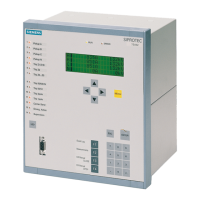2.10 Automatic Reclosure Function (optional)
125
7SD610 Manual
C53000-G1176-C145-4
reclose function). If no trip command is present before the action time expires, the cor-
responding reclosure cycle is not carried out.
For each reclosure cycle, you may set whether or not it allows the initiation. Following
the first general pickup, only the action times of those cycles that are set such that they
may start off the recloser are considered since the other cycles are not allowed to be
the first cycle under any circumstances. By means of the action times and the permis-
sion to start the recloser (permission to be the first cycle that is executed) it is possible
to determine which reclose cycles are executed depending on the time used by the
protection function to trip.
Example 1
: 3 cycles are set. Starting of the auto-reclosure is allowed for at least the
first cycle. The action times are set as follows:
• 1st Reclosure: T Action = 0.2 s;
• 2nd Reclosure: T Action = 0.8 s;
• 3rd Reclosure: T Action = 1.2 s;
Since reclosure is ready before the fault occurs, the first trip of a time overcurrent pro-
tection following a fault is fast, i.e. before the end of any action time. The automatic
reclosure function is therefore started (the first cycle is initiated). After unsuccessful
reclosure the 2nd cycle would then become active; but the time overcurrent protection
would not trip in this example until after 1s according to its grading time. Since the
action time for the second cycle was exceeded here, it is blocked. The 3rd cycle with
its parameters is therefore carried out now. If the trip command only appeared more
than 1.2s after the 1st reclosure, there would have been no further reclosure.
Example 2
: 3 cycles are set. Starting is only allowed for the first. The action times are
set as in example 1. The first protection trip takes place 0.5 s after starting. Since the
action time for the 1st cycle has already expired at this time, this cannot start the au-
tomatic reclose function. As the 2nd and 3rd cycles are not permitted to start the
reclose function they will also not be initiated. Therefore no reclosure takes place as
no starting took place.
Example 3
: 3 cycles are set. At least the first two cycles are set such that they can start
the recloser. The action times are set as in example 1. The first protection trip takes
place 0.5 s after starting. Since the action time for the 1st cycle has already expired at
this time, it cannot start the automatic reclosure function, but the 2nd cycle, for which
initiating is allowed, is activated immediately. This 2nd cycle therefore starts the auto-
matic reclosure circuit, the 1st cycle is practically skipped.
Operating modes of
the automatic
reclosure
The dead times — these are the times from elimination of the fault (drop off of the trip
command or signalling via auxiliary contacts) to the initiation of the automatic close
command — may vary depending on the automatic reclosure operating mode select-
ed when determining the function scope and the resulting signals of the starting pro-
tective functions.
In control mode TRIP... (With TRIP command ...) single-pole
or single-/three-pole
reclose cycles are possible if the device and the circuit breaker are suitable. In this
case, different dead times (for every AR cycle) are possible after single-pole tripping
and after three-pole tripping. The protective function that issues the trip command de-
termines the type of trip: Single-pole or three-pole. The dead time is controlled depen-
dent on this.
In control mode PICKUP ... (With PICKUP...) different dead times can be set for
every reclose cycle after single-
, two- and three-phase faults. Here the decisive factor
is the pickup diagram of the protective functions at the instant the trip command dis-
appears. This mode enables to make the dead times dependent on the type of fault in
the case of three-pole reclose cycles.
www . ElectricalPartManuals . com

